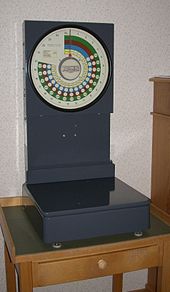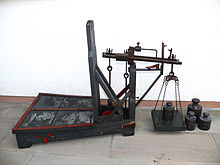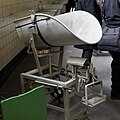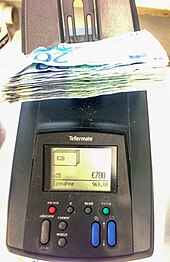Libra
A scale is a measuring device for determining a mass . Usually this takes place via the weight force .
The weight force is either measured directly, such as with a spring balance , or it is compared with the weight force of a known mass. An example of this is the beam balance . In the case of scales of the first type, the measurement result depends on the severity , which differs locally, which is described by the “spatial factor”. In the case of balances of the second type, the gravity is the same for both masses compared and is therefore irrelevant for the result. In both types, the weight value is influenced by the static buoyancy in the air. Depending on the application and the required accuracy, these influences are neglected or taken into account through suitable measures.
A special form is the counting scale , which determines the number of many identical objects from the mass of one or more individual pieces.
Relationship between mass and gravitational acceleration
The context applies
In this simplified equation the following are neglected (which is permissible depending on the required accuracy):
- The different gravitational acceleration at different points on the earth's surface or at different times,
- the hydrostatic buoyancy of the weighing sample in the surrounding medium (mostly air),
- Magnetic interactions of the goods to be weighed, of components of the balance or of surrounding objects,
- electrostatic interactions .
properties
- Weighing range
- Readability
- Precision (see also: accuracy class of a weighing system )
- reproducibility
- Linearity
- Size (variable)
- Position (e.g. bench scale, floor scale, crane scale )
history


A balance beam from the 5th millennium BC Was discovered in a prehistoric tomb in Egypt . The earliest Egyptian images of simple beam scales date from around 2000 BC. The suspension of the balance beam consisted of a rope, at its outer ends the balance pans hung. Around 500 BC Etruscans improved the accuracy of the beam balance. The Romans also knew unequal-arm scales, the longer arm carried a movable weighing element and a line marking. In the Renaissance , highly sensitive analytical scales were used in alchemical laboratories.
In 1669 the Frenchman Gilles Personne de Roberval invented the table scales. It had the advantage that the position of the load to be weighed on the weighing pans did not affect the result. In 1763 the Swabian pastor Philipp Matthäus Hahn built an inclination scale with a direct weight display. Decimal and kitchen scales were created in the first half of the 19th century. Around 1850 attempts were made to automatically print the weighing result. In 1895, scales with simultaneous price displays appeared in the USA (price-calculating scales). In 1939, two American engineers introduced the age of electronic scales with the use of changes in electrical resistance.
Mechanical scales
In the case of mechanical scales, a distinction is made between the above two basic principles, weight measurement and mass comparison.
Weighing by measuring the weight
In the simplest form of spring scales, the object to be weighed is hung on a coil spring and the extension is measured. Based on the spring constant , the weight force is determined and mapped to the mass with the corresponding scale . Related measuring principles are also based on deformation measurement, for example with membranes , force sensors , load cells , piezo effect or ring torsion .
There are spring balances and force gauges for different measuring ranges . Examples:
- a simple spring balance is also popularly known as a "rag scale"
- High quality spring balances in round design with pointer (pointer high-speed balance)
- Household scales, a handheld / table-top device up to about 10 kg
- Kitchen scales and baby scales, up to 5 or 10 kg
- Personal scales for body weight (usually up to 130 or 150 kg, accuracy 0.1 to 3 kg).
- Floor-standing devices for industrial purposes or in trade (weighing range / scale division mostly 25 kg / 50 g, 50 kg / 100 g or 100 kg / 200 g, accuracy 0.1–0.2%).
- Membrane balances and barometers
- Microbalances and precision spring balances for laboratories, physics classes etc., accuracies 0.1–0.5%.
Weighing by mass comparison


The mass of a body is determined by comparing it with standard weights. These scales also work with gravity , but do not have to be adjusted to the different local conditions and could therefore also be used on other celestial bodies, such as the moon. Usual reference weights start at 1 mg for pharmacy scales and end at 10 kg for market scales.
- A beam balance measures the balance of two torques generated by the weights of the goods to be weighed and the calibration weight . In the simplest case, it is a balance beam mounted at the pivot point, at the ends of which two weighing pans are suspended at the same distance from the pivot point. A variant of the beam balance that was previously found in many households and kitchens is the table balance (Roberval balance), in which the weighing pans are attached to a lever parallelogram and are located above the balance beam.
- A high-speed scale , also known as a linear mass scale or a sliding weight scale , formerly also called Besemer , consists of a rod that is divided into two unequal lever arms during the weighing process. The balance weight is on one lever arm and a hook for hanging up the goods on the other. The ratio of the lever arms can be shifted with a tongue and handle until equilibrium is achieved with the weighing object attached. High speed scales were used by Greeks, Romans and Chinese as early as pre-Christian times . There may be a scale on the stick.
- A decimal scale is suitable for larger loads. It also works on the principle of the two-sided lever and is designed in such a way that, for example, a mass of 100 kg to be weighed is weighed with a reference weight of 10 kg.
- An incline scale measures the deflection of a fixed weight on a lever arm. This principle is used in many letter scales .
- Mass comparisons can also be carried out on single-pan scales (or on double-pan scales in which a counterweight remains on one pan) using a suitable procedure (substitution weighing, Borda substitution). This is the usual procedure for mass comparisons on mass comparators to calibrate weights. This process produces the highest weighing accuracy and can be used on mechanical and electronic scales.
Roman speed scale from Pompeii
Electronic and electromechanical scales
Today, mechanical devices are largely replaced by electronic scales. They are more robust, more accurate, easier to read and often cheaper. Electronic analytical balances often have a housing to protect against air movements, programs for calibration and special damping to prevent vibrations. They measure in the range of a few hundred grams (typically 200-300 g) with a readability of up to 0.1 mg, which corresponds to a resolution of 10 6 .
How electronic scales work
Measurement of a deformation
Electric scales work either by converting the weight force , which cannot be measured directly, into a deformation or a path. This is usually achieved by means of a spring or a bending beam , whereby the spring in a crane scale can be a relatively solid metal block.
The direct method measures the deformation of the spring / the bending beam using a strain gauge ; the indirect path measurement can e.g. B. be done via the change in capacitance of a capacitor when changing the plate spacing.
Electromagnetic force compensation
More accurate scales work on the principle of electromagnetic force compensation. A counterforce is generated by a coil in a permanent magnet , which corresponds to the load of the sample to be measured on the weighing pan. With this counterforce the balance is kept. This is done by a position sensor and a control amplifier, which are necessary to maintain the state of equilibrium. A lever system enables a larger force to be kept in equilibrium with a smaller counterforce. The coil current is measured as a voltage drop across a measuring resistor and processed and displayed by an analog-digital converter . With this principle, there is no significant deformation, which leads to a higher accuracy compared to deforming principles.
Electromechanical scales for industry and transport
In modern electromechanical scales, two main sensor principles are used:
- Scales with load cells that work with strain gauges (DMS, Strain Gage)
- Scales based on the principle of electromagnetic force compensation
Scales with sensor elements that work with vibrating strings or with which capacitive or piezoresistive sensors are used are also less common .
Examples:
- Platform and vehicle scales: Weighing platforms (weighbridges) with several load cells and a measuring terminal
- Road bridge scale for truck and silo transport
- Bridge scales for railroad cars
- Static / dynamic axle load scale
- Crane scales with 10–20 measuring ranges of ± 0.2% each
- Pallet scales (e.g. 10 to 1500 kg ± 0.5 kg)
- Special scales for long goods, heavy industrial use, etc.
- Weighing terminals with filling control (see: filling scales ) for liquids, big bags , dosing, loading, etc.
- Floor scales with function and numeric keypad and standard programs
Counting scales
Counting scales reverse the measuring principle of weight comparison by calculating the counting size from the ratio of the weight of a quantity of pieces to a single one of these pieces. In the case of large quantities, one also compares the weight of a larger quantity, around 100 pieces.
Special scales for technology and physics
- Six-component scale: By measuring the three forces and the three torques in an orthogonal coordinate system , such a scale can be used, for example, to measure all the effects of the air flow on a model in a wind tunnel .
- Gravimeter for geophysics and geodesy : precision “spring balance” (inclined beam) or with superconductivity , measurement of the earth's gravity field from 950 to 990 Gal ± 0.001 mGal (1 Gal = 1 cm / s²).
- Rotary balance ( Henry Cavendish determined the gravitational constant with a rotary balance in 1798 )
- Watt balance : it compares mechanical with electrical power ; Use is the implementation of the SI unit kilogram according to the current definition.
- Comparator scale or mass comparator for comparing pieces of mass. The most precise devices allow measurements in a vacuum (0.005 mbar). This avoids the necessary corrections due to the different static buoyancy of the standard and test specimen in the air. The currently most accurate mass comparator of PTB has a standard deviation of 1 * 10 −10 kg.
- Cotton scales (a magnetic scale ) for quickly and accurately measuring the weight of coins, invented by William Cotton while he was director of the Bank of England from 1842 to 1845.
- Air weight meter , density meter
Types of scales
After application
For people and the household:
Commercial:
Medical:
For vehicles:
Historical:
According to type
- Beam balance
- Decimal scale, often as a bag scale with a platform and wall to lean the bag on
- Spring balance
- Crane scales
- Multihead weigher
- Tilt balance
- Ring dynamometer
- Pan scales
- Table scales
- Moon scales with an elliptically curved leaf spring ellipse, inside of which the protected pointer and crescent moon -shaped scale
- Pointer balance
For accuracy
Precision balances achieve accuracies of up to 0.01%. Classification according to accuracy:
- Microbalance , e.g. B. with a digit increment of 1 µg
- Analytical balance , e.g. B. with a digit increment of 0.1 mg
- Precision balance , with a number step from 1 mg to 100 mg
- Commercial scales
- Coarse scale
Word history
Etymology and spelling
The word scales ( ahd. Wāga , mhd. Wāge ) is related to the verb to move . Both words go back to an Indo-European root that means "to move". In the original sense of the word, a scale is a moving, vibrating object. The verb dare (mhd. To weigh ) with the meaning “dare to risk something” is a derivation from mhd. Wāge (= scales) and actually means “to put something on the scales”.
In 1927, the case was to better differentiate to cars of scales to balance changed.
Weighing and Weighing
The verbs weigh and weigh both mean “to determine the weight”, but differ in word history and in word usage today.
- The older verb is to weigh ( ahd. Wegan , mhd. Because of ). Originally it meant “to move”. The prefix -Verb move is from the old verb because derived and took over its original meaning. For the meaning “determine the weight”, the spelling weighed (instead of because of ) was developed in the 16th century under the influence of wage (= scales ). From the meaning “determine the weight” the transferred meaning “consider carefully”, “consider” developed.
- The verb weigh is a younger variant of weigh . It originated in the 16th century from two inflected word forms of weigh : (you) weigh and (he) weighs .
- There is no difference in the past and perfect tense, both words have weighed, weighed ; weighed, weighed occurs only in the figurative meaning.
Determining the weight is almost exclusively expressed in common language today with the younger verb weigh . In the technical jargon, however, we have held out. In addition, weighing in Switzerland in use.
The verb weigh the same in the present tense (but weak: weighed, weighed ) with the meaning "gently move back and forth" is derived from cradle . The words cradle and scales are not directly related, but they probably go back to the same Indo-European word root with the common basic meaning "moving object".
Transferred word usage
The device was particularly popular in religious iconography in the image of the soul scales .
The word scales is also used in terms for some technical devices that are not used to determine weight:
- The horizontal or vertical alignment is checked with a spirit level .
- The plumb level is the historic forerunner of the spirit level. Only the horizontal alignment can be checked with a level.
- A drop scale is used to determine the density or specific weight of liquids. A well-known example is the must scale (also called Oechsle scale ), which is used to measure the density of grape must . The measurement of the specific weight (= weight per volume) is almost the same as a weight measurement, in this respect a lowering scale can actually be considered a “scale for liquids”.
- With a rotary balance , very small forces are measured, e.g. B. the attraction of mass between two bodies.
In common parlance, some idioms make use of the image of the scales:
- keep yourself in balance
- put every word on the gold scales
literature
- Heinrich Böll : The scales of the Baleks
- Karl Erich Haeberle: Ten thousand years of Libra. From the history of the development of weighing technology . Bizerba-Werke, Balingen 1967.
- Hans R. Jenemann, Arno M. Basedow, Erich Robens: The development of the macro vacuum balance , Wirtschaftsverlag NW and others, Bremerhaven 1992, ISBN 3-89429-214-8 , ( PTB report - TWD 38).
- Manfred Kochsiek (Ed.): Manual of weighing . 2nd revised and expanded edition. Vieweg, Braunschweig et al. 1989, ISBN 3-528-18572-4 .
- Roland Nater, Arthur Reichmuth, Roman Schwartz, Michael Borys, Panagiotis Zervos: Weighing Dictionary: Guide to Weighing Terms , Springer, Berlin Heidelberg 2008, ISBN 978-3-540-75907-2 .
- Richard Vieweg : From the cultural history of the scales . Bizerba-Werke, Balingen 1966.
- Hans R. Jennemann: About ancient Egyptian small scales and related weighing instruments . In: Technikgeschichte, Vol. 62 (1995), H. 1, pp. 1–26.
Web links
Individual evidence
- ^ Besemer in Meyers Konversations-Lexikon , 4th edition (1885-1892), retrobibliothek.de
- ↑ On the Science of Weighing and Measuring, and the Standards of Weight and Measure, https://www.nature.com/articles/009047a0 Nature 9, 47-49 (1873)
- ↑ Functionality of the electromagnetic force compensation , in technology differentiation - the successful strategy of Sartorius AG , p. 11 (PDF; 1.1 MB)
- ↑ a b Duden online: Libra
- ↑ Duden online: dare
- ↑ Announcement of the Reich Minister of the Interior of July 5, 1927 (Reichsministerialblatt 1927, No. 29, p. 205); Duden 1929, faql.de
- ↑ a b Duden online: weigh
- ↑ a b Duden online: weigh (to scales and weigh )
- ↑ Duden online: weigh (to cradle )
- ↑ Duden online: cradle
- ↑ Duden online: Goldwaage














